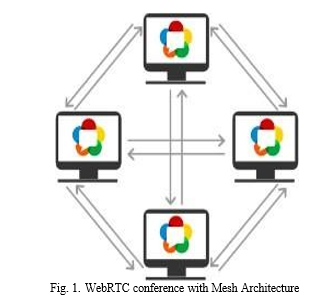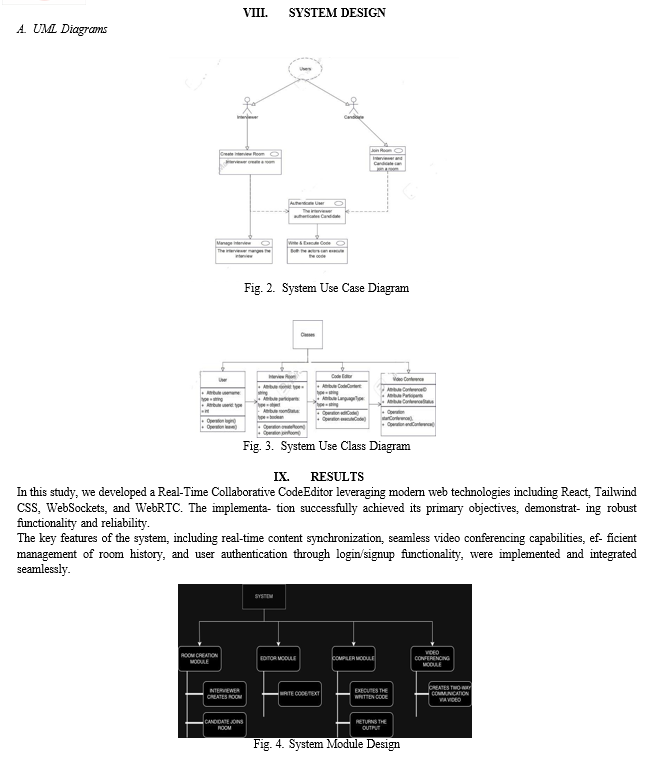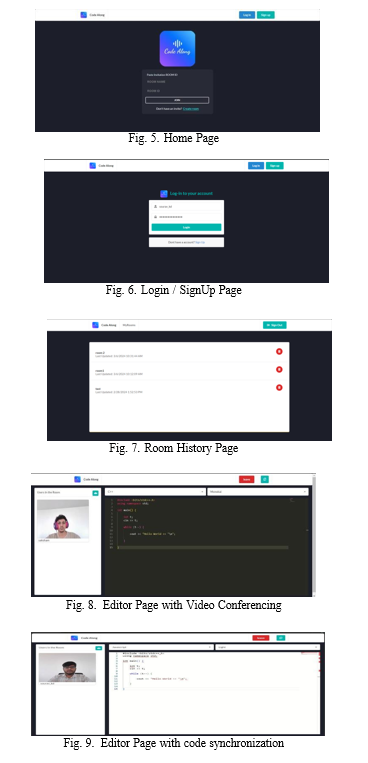Ijraset Journal For Research in Applied Science and Engineering Technology
- Home / Ijraset
- On This Page
- Abstract
- Introduction
- References
- Copyright
Real Time Collaborative Code Editor
Authors: Dr. N.V. Raja Sekhkar Reddy, Satvik Pothukuchi, Rahul Sivapuram
DOI Link: https://doi.org/10.22214/ijraset.2024.63870
Certificate: View Certificate
Abstract
The main goal of our project is to provide an online platform especially for group coding interviews. This platform provides a comprehensive environment for seamless communication between interviewers and candidates, with the goal of addressing the challenges faced during remote technical assessments. The creation of a feature-rich web platform is the goal of our project. This includes an adaptable rich text editor that enables coding in real time, a mechanism for instantaneous code evaluation via execution and compilation, integrated video conferencing for efficient communication, and the ability to set up interview rooms to hold several interviews at once. We\'re designing a user intuitive interface using technology and strong programming frameworks. The main objectives of the platform are to ensure real time code execution and a seamless interview process. This is achieved by incorporating code compilation engines implementing editing tools and utilizing WebRTC for video conferencing. By creating a user-friendly and productive environment that benefits both interviewers and candidates, our platform seeks to expedite the remote technical interview process. This means reducing logistical obstacles, making thorough coding evaluations possible, and creating a positive interview environment. The platform serves a wide range of customers, such as candidates looking for an environment that allows them to demonstrate their coding talents, interviewers looking for effective assessment tools, and tech businesses conducting remote interviews.
Introduction
I. INTRODUCTION
The goal of the creative project known as the Online Collaborative Coding Interview Platform is to revolutionize the field of remote technical evaluations. A committed team created this platform to ease interviewers' and candidates' collaboration during coding interviews. A powerful rich text editor with real-time code execution and compilation capabilities, integrated video conferencing for efficient communication, and the ability to create interview rooms for simultaneous interviews are some of its primary features. Utilizing cutting-edge technologies and a user-centric methodology, the platform strives to optimize the remote interview process by offering a safe, effective, and intuitive environment. This project's ultimate goal is to provide the best possible option for conducting and participating in remote coding interviews for IT businesses, interviewers, and candidates.
II. LITERATURE SURVEY
- Thorat, Adhiksha & Bhute, Avinash. (2022). Squash- Cord: Video Conferencing Application Using WebRTC explores the practical application, design, implementation, and constraints of utilizing WebRTC (Web Real-Time Communi- cation) technology in real-world scenarios. WebRTC, an open- source technology, facilitates instantaneous communication and data transfer across various browsers and devices. It equips developers with JavaScript-based Application Programming Interfaces (APIs). Primarily, WebRTC relies on peer-to-peer (P2P) communi- cation, enabling direct connections between devices for real- time transmission of data, audio, and video. In scenarios where users are situated across different IP networks with firewalls impeding Network Address Translation (NAT), WebRTC in- corporates Session Traversal Utilities for NAT (STUN) servers. These STUN servers enable the translation of internal IP addresses to public internet addresses, overcoming obstacles to Real-Time Communication (RTC) caused by firewall restrictions. This mechanism aids in establishing peer connections, allowing seamless communication despite firewall constraints and varying IP network configurations.”
- Nimitbunanan, Narongchai & (U.S, Naval. (1997) Video Conferencing with Packet Radio Technology: In today’s rapidly evolving landscape, the efficient dissemination and delivery of information stand as pivotal elements. Videoconferencing, owing to its interactive nature, emerges as a highly effective means of information distribution. This the- sis focuses on exploring packet-radio-networking technology, which forms the backbone of video-conferencing applications. The study delves into the prevalent networking proto- cols employed within packet radio technology, elucidating on systems like Amateur X.25 (AX.25), Transport Control Protocol/Internet Protocol (TCP/IP), among others. To evaluate performance, the study collected and analyzed data on the average speed and duration of varying file sizes across different channels: a half-duplex radio channel, a full-duplex emulated radio channel, and an RS-232 link. The assessment was conducted utilizing the File Transfer Protocol (FTP) of the TCP/IP standard.
Additionally, the study included comparisons among these channels and investigated the implications of introducing an additional routing node. The overarching aim was to underscore the potential synergies between these technologies, emphasizing how such integration could fortify cybersecurity defenses and proactively safeguard users.
3. Rachel Roberts (2009). Sami Andberg (2008). Post Graduate Thesis: Technological advancements have ushered in a new era for video communication in classrooms, previously confined to research domains. With improved compression and affordable devices, standard internet connections now deliver superior-quality transmissions. This evolution has seen web conferencing surge in popularity, supplanting travel plans due to budgetary constraints within businesses and institutions (Sami, 2008; Roberts, 2009). The shift signifies a significant change in how communication technology, once limited to specialized settings, has become accessible and indispensable for widespread use in various professional and educational settings, marking a pivotal transformation in communication norms.
4. V. Beltran and E. Bertin’s 2015 paper, ”Unified Communications as a Service and WebRTC: An Identity- Centric Perspective,” published in Computer Communications, explores integrating enterprise communication into Unified Communications (UC), encompassing voice, video, voicemail, and more under Unified Communications as a Service (UCaaS). Web Real-Time Communications (WebRTC) enable real-time voice and video, yet the shift to Software-as- a-Service (SaaS) raises security concerns in enterprise Identity Management (IDM). While WebRTC enhances browser capabilities, its role in managing user identity remains unaddressed, complicating IDM within cloud services. The paper outlines IDM requirements in UCaaS, discussing models for cloud-based corporate services and suggesting minor WebRTC adjustments to meet evolving business IDM needs.
III. PURPOSE
Primary purpose of the project is to create an online plat- form specifically tailored for collaborative coding interviews. It aims to address the challenges faced in remote technical assessments by providing a comprehensive environment that fosters seamless interaction between interviewers and candidates. This purpose-driven initiative seeks to revolutionize the remote interview process by offering a feature-rich platform equipped with real-time code execution, integrated video con- ferencing, and collaborative editing tools.
IV. PROPOSED SYSTEM
The proposed system entails the development of an all- inclusive, dedicated online platform specifically engineered to revolutionize the landscape of remote technical assessments.
This innovative platform is meticulously designed to address the shortcomings of the current disparate systems by amalgamating essential features into a cohesive, integrated environment.
The development of this platform relies on cutting-edge technologies and robust programming frameworks. Utilizing WebRTC for video conferencing integration, server-side exe- cution environments, and secure authentication protocols, the system ensures a secure and seamless user experience. The team follows an agile development methodology, incorporating iterative improvements based on user feedback to refine and enhance the platform continuously.
V. IMPLEMENTATION TECHNOLOGIES
Define abbreviations and acronyms the first time they are used in the text, even after they have been defined in the abstract. Abbreviations such as IEEE, SI, MKS, CGS, ac, dc, and rms do not have to be defined. Do not use abbreviations in the title or heads unless they are unavoidable.
A. WebRTC
- WebRTC facilitates real-time communication through web browsers.
- Integrated for video conferencing functionalities within the platform, enabling face-to-face interaction during interviews.
B. Rich Text Editor
- Enables users to write, edit, and execute code within the platform.
- Supports syntax highlighting, auto-completion, and for- matting for various programming languages, aiding can- didates in coding tasks during interviews.
C. Interpreters/Execution Engine
- Executes and evaluates code in real-time.
- Integrates interpreters for multiple programming lan- guages (e.g., Python, JavaScript, Java) within the platform to enable immediate code execution and assessment.
D. Web Technologies (React.js, CSS)
- Frameworks and languages for building web applications.
- Used to develop the platform’s front-end interface, en- suring compatibility across browsers and providing an interactive user experience.
E. Server Technologies (Node.js, Express.js)
- Backend frameworks for server-side development.
- Facilitates server-side processing, handles requests, man- ages databases, and maintains the platform’s functional- ity.
- The socket connection and communication will be han- dled by Socket.io package.
- NPM is the package manager used.
VI. WEBSOCKETS
In the realm of web-based real-time communication (RTC), WebSockets have emerged as a pivotal technology. Unlike traditional HTTP requests, which are stateless and lack real- time capabilities, WebSockets facilitate persistent, bidirec- tional communication channels between clients and servers. This feature makes them an ideal choice for applications requiring instant data exchange, such as video conferencing systems.
A. How WebSockets Work
- WebSockets operate over a single, full-duplex connection, enabling both the client and server to initiate data transfer at any time without relying on periodic polling. This persistent connection significantly reduces latency and overhead compared to traditional HTTP-based approaches, making it well-suited for real-time applications like video conferencing.
- At the heart of WebSocket communication lies a hand- shake process initiated through an HTTP request. Once the handshake is complete, the connection upgrades to the WebSocket protocol, allowing continuous data exchange without the overhead of HTTP headers.
B. Advantages of WebSockets in Video Conferencing
- Low Latency: WebSockets reduce latency in audio and video transmission by enabling almost immediate data flow. For video conferencing scenarios to remain fluid, the communication must have low latency, as even little delays can break the flow of the conversation.
- Effective Bandwidth Utilization: WebSockets minimize needless network overhead by doing away with the requirement for frequent HTTP requests and responses. This effectiveness is especially helpful for video conference applications, where bandwidth optimization is necessary to provide a smooth experience, especially when there are several participants. WebSockets facilitate bi-directional data communication, which permits asynchronous data push from the server to the client, which is a web browser. Real-time collaboration tools in video conferencing, such file sharing, chat messaging, and live annotations, depend on this capacity.
- Scalability: WebSockets support concurrent connections, making them highly scalable for large-scale video confer- encing deployments. Whether hosting small team meetings or large virtual conferences, WebSocket-based so- lutions can accommodate varying levels of user activity without sacrificing performance.
- Compatibility: Most modern web browsers and server- side frameworks support WebSockets, ensuring broad compatibility across different devices and platforms. This ubiquity simplifies the development and deployment of video conferencing applications, allowing seamless com- munication experiences for users worldwide.
VII. WEBRTC MESH ARCHITECTURE
WebRTC (Web Real-Time Communication) has revolu- tionized real-time communication on the web by providing a standardized framework for enabling peer-to-peer audio, video, and data transmission directly between web browsers. One of the key architectural approaches within WebRTC is the mesh topology, which offers simplicity and scalability

for video conferencing applications. This section explores the integration of WebRTC with mesh topology architecture in the context of our coding interview platform.
A. Understanding Mesh Topology Architecture
In a mesh topology, each participant in a video conference is connected directly to every other participant, forming a network of interconnected nodes. Unlike centralized or server- based architectures, mesh topology distributes the communi- cation load across all participants, enabling decentralized peer- to-peer communication without relying on a central server for data routing. This decentralized nature of mesh topology enhances scalability and fault tolerance, as participants can dynamically join or leave the conference without disrupting the overall communication flow.
B. Advantages of Mesh Topology with WebRTC
- Scalability: Seamless scalability in video conferencing applications is made possible by mesh topology architecture. As more people join the conference, they link directly with those who have already attended, doing away with the need for centralized media servers to handle lines of communication. This decentralized method facilitates large-scale conferencing and guarantees effective use of network resources.
- Low Latency: Mesh architecture reduces the transmission delays usually associated with centralized media servers by enabling peer-to-peer communication. Direct stream exchange between participants improves real-time interaction during video conferences by lowering latency. In order to preserve a natural conversation flow and responsiveness in our coding interview platform, low-latency communication is essential.
- Redundancy and Reliability: Mesh topology provides inherent fault tolerance and redundancy since every member of the network is connected to several peers. If a member disconnects or encounters network problems, communication can still be maintained via other channels set up inside the mesh. This resilience improves the user experience for interviews held on our platform by guaranteeing high availability and dependability in video conferencing circumstances.
- Privacy and Security: No middlemen or centralized servers are required to relay media streams because data is transferred directly between peers in a mesh architecture. Peer-to-peer communication models improve security and privacy since private audio and video content stays inside the browsers of conference participants, lowering the possibility of illegal access or eavesdropping.


Through rigorous testing and evaluation, the system demon- strated its ability to facilitate concurrent editing of code in real- time, ensuring consistent collaboration among users regardless of geographical location. The incorporation of WebRTC tech- nology enabled smooth video conferencing sessions within the code editing environment, enhancing the collaborative experience.
Furthermore, the system’s scalability and performance were evaluated under various load conditions, demonstrating sta- bility and responsiveness even with a significant number of concurrent users.
Overall, the Real-Time Collaborative Code Editor project represents a significant advancement in enabling collaborative software development practices, offering a versatile and user- friendly platform for remote teamwork and code collaboration.
X. ACKNOWLEDGMENT
The elation and contentment accompanying the successful culmination of any task are truly amplified by acknowledging those instrumental in making it possible. Their unwavering guidance and unwavering encouragement have truly crowned our efforts with success. It is indeed heartening to have this opportunity to extend our gratitude to each of them.
Foremost, we extend our deepest appreciation to our internal guide, Dr. M. KALPANA CHOWDARY, Associate Professor in the Department of CSE, whose unwavering support was instrumental in completing our dissertation. Our sincere thanks are also due to Dr. A. BALARAM, HOD of the Department of CSE, and Principal Dr. K. SRINIVAS RAO for providing us with the necessary facilities to see our dissertation through to completion.
We express our heartfelt gratitude to all our faculty members and friends for their invaluable assistance and constructive critique throughout the project duration. Finally, we owe an immeasurable debt of gratitude to our parents for their unwavering moral support and ceaseless encouragement in helping us achieve our goals.
References
[1] Thorat, Adhiksha Bhute, Avinash. (2022). Squash Cord: Video Confer- encing Application Using WebRTC. [2] Thompson, Janet Arunachalan, Bhuvaneswari. (2005). Video Confer- encing Using H.323 Standard. [3] Rachel Roberts (2009). V1. Sami Andberg (2008). Post Graduate Thesis: Video Conferencing in Distance Learning. Department of Computer Science, University of Helsinki. [4] Bertin, E. and Beltran, V., Unified communications as a service and WebRTC: Anidentity - centric perspective, Computer Communications [5] CodeR: Real-time Code Editor Application for Collaborative Program- ming - by Aditya Kurniawan. [6] Full-body WebRTC video conferencing in a web-based real-time col- laboration system - by Christoph Meinel. [7] On the Scalability of WebRTC with Information-Centric Networking - Publisher IEEE
Copyright
Copyright © 2024 Dr. N.V. Raja Sekhkar Reddy, Satvik Pothukuchi, Rahul Sivapuram. This is an open access article distributed under the Creative Commons Attribution License, which permits unrestricted use, distribution, and reproduction in any medium, provided the original work is properly cited.

Download Paper
Paper Id : IJRASET63870
Publish Date : 2024-08-03
ISSN : 2321-9653
Publisher Name : IJRASET
DOI Link : Click Here
 Submit Paper Online
Submit Paper Online

